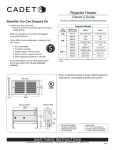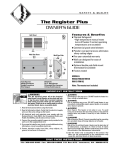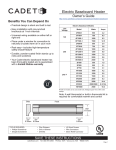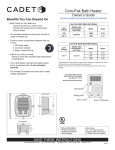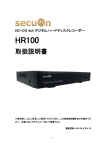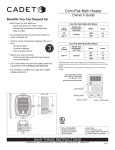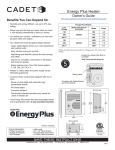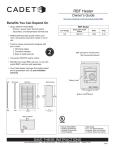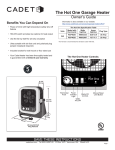Download Cadet NLW452T Operating instructions
Transcript
NLW Heater Owner’s Guide http://www.cadetheat.com/products/wall-heaters/NLW Benefits You Can Depend On NLW Models • Quiet, comfortable warmth delivered with a large fan that gently circulates air Line Voltage • Safe for you and your family Peace of mind with automatic high temperature shutoff feature 208 • Improve air circulation and add comfort to your home in off-season with a fan only switch 240 (2) • Common sense components designed with you in mind Model w/ Thermostat and Fan Switch (1) Watts NLW208T 2000 9.6 NLW308T 3000 14.4 NLW408T 4000 19.2 NLW202T 2000/1500 8.3/7.2 NLW302T 3000/2250 12.5/10.8 NLW402T 4000/3000 16.7/14.4 NLW452T 4500/3375 18.8/16.2 Amps (1) Standard built-in thermostat is double pole and provides “OFF” position. (2) 240 volt models can be used at 208 volts. Wattage equals 75% of 240v rated 1. NO sharp edges 2. Corrosion resistant 3. Easy to install wattage. New installation requires wall can (sold separately): Model Numbers NLWC Recess Mount or NLWCS Surface Mount. • Your Cadet heater has been thoroughly tested and is guaranteed with a 2 year extended warranty NLW with Thermostat Wall Thermostat Not Required Built-in Thermostat Wall Can Top 141/8” 35.88cm 4” 10.16cm 15” 38.1cm Side Grill Front Wall Can Side Reset Button Rating Label 21” 53.34cm 13/16” 2.06 191/8” 48.58cm 16¾” 42.54cm TOOLS REQUIRED: • Phillips Screwdriver • Straight Screwdriver • Wire Strippers • Utility Knife • (4) 1 1/2“ Wood Screws • Insulated Wire Connectors • (1) Strain Relief Connector SAVE THESE INSTRUCTIONS cadetheat.com Tel: 360-693-2505 PO Box 1675 Vancouver, WA 98668-1675 Page 1 IMPORTANT INSTRUCTIONS WARNING When using electrical appliances, basic precautions should always be followed to reduce the risk of fire, electric shock, and injury to persons, including the following: 1. Read all instructions before installing or using 7. WARNING this heater. Risk of Electrical Shock. Do not insert or allow foreign objects to enter any ventilation or exhaust 2. WARNING opening as this may cause an electric shock or Risk of Fire. This heater is hot when in use. Caution—High Temperature. Risk of Fire. Keep fire, or damage the heater. electrical cords, drapery, furnishings, and other 8. WARNING combustibles at least 3 feet from the front of the Risk of Fire. To prevent a possible fire, do not heater and 6 inches above and on both sides. block air intakes or exhaust in any manner. 3. WARNING 9. WARNING Burn Hazard. To avoid burns, do not let bare skin Fire or explosion may occur. A heater has hot and touch hot surfaces. Extreme caution is necessary arcing or sparking parts inside. Do not use it in when any heater is used by or near children or areas where gasoline, paint, or flammable vapors invalids and whenever the heater is left operating or liquids are used or stored. and unattended. 10. Use this heater only as described in this 4. WARNING manual. Any other use not recommended by the Risk of Electrical Shock. Do not operate any manufacturer may cause fire, electrical shock, or heater after it malfunctions. Disconnect power injury to persons. at service panel and have heater inspected by a 11. The heater must be properly installed before qualified electrician before reusing. it is used. 5. WARNING 12. WARNING Do not use outdoors. Risk of Electrical Shock and Fire. Do not operate 6. To disconnect heater, turn controls to off, and without grill. turn off power to heater circuit at main disconnect 13. Save these instructions. panel. Wiring Diagram L1 THERMOSTAT L2 FAN SWITCH 6 4 3 1 THERMAL LIMIT MOTOR HEATING ELEMENT SAVE THESE INSTRUCTIONS Page 2 cadetheat.com Tel: 360-693-2505 PO Box 1675 Vancouver, WA 98668-1675 INSTALLATION INSTRUCTIONS 1. WARNING Verify that the electrical supply wires are the same voltage as the heater. 2. If replacing an existing heater, check the label of the old heater. 3. All electrical work and materials must comply with the National Electric Code (NEC), the Occupational Safety and Health Act (OSHA), and all state and local codes. 4. If you need to install a new circuit or need additional wiring information, consult a qualified electrician. 5. Use copper conductors only. 6. WARNING Risk of Electrical Shock. DO NOT install the heater directly above bathtub or sink. DO NOT install in shower stall area (Manufacturer recommends a minimum 2 foot clearance). 7. Heater must be installed in a wall can: Model NLW Wall Can NLWC or NLWCS __________________________ 8. WARNING Risk of Fire. DO NOT install the heater in a floor, in the ceiling, below a towel bar, behind a door, or anywhere the air discharge may be blocked in any manner. 9. WARNING Fire or Explosion May Occur. A heater has hot and arcing or sparking parts inside. Do not use it in areas where gasoline, paint, or flammable vapors or liquids are used or stored. 10. WARNING Risk of Electrical Shock. Connect grounding lead to grounding screw provided. Keep all foreign objects out of heater. 11. WARNING Risk of Fire. This heater is hot when in use. Caution—High Temperature. Risk of Fire. Keep electrical cords, drapery, furnishings, and other combustibles at least 3 feet from the front of the heater and 6 inches above and on both sides. Part One __________________________ PLACEMENT: For best results install the NLW heater on an inside wall. Headers and bracing are not necessary. NOTE: The wall can must be installed in the TOP UP (vertical) position only. Heater is not approved for ceiling mount. THERMOSTAT: A built-in double pole thermostat is included. How do I install for new construction? STEP 1 Mount The Wall Can How do I install in an existing wall? STEP 1 Cut A Hole In The Wall REQUIRED MINIMUM distance of 6 inches from adjacent surfaces and 6 inches from the floor (See Figure 3). However, Cadet RECOMMENDS 12 inches from adjacent surfaces and floor for longer and cleaner performance. Heaters must be spaced at least 3 feet apart. Secure the wall can to the studs with screws through the larger (3/16 inch) holes. (See Figures 1 and 2). Cut a hole 14 1/4 inches wide by 19 1/4 inches high next to a wall stud. REQUIRED MINIMUM distance of 6 inches from adjacent surfaces and 6 inches from the floor (See Figure 3). However, Cadet RECOMMENDS 12 inches from adjacent surfaces and floor for longer and cleaner performance. Heaters must be spaced at least 3 feet apart. Figure 3 Figure 1 STEP 2 Route Supply Wires Figure 2 Face of wall can must extend 1/2 inch or 5/8 inch from face of stud to allow for thickness of sheetrock. Mount wall can flush with finished surface. Route supply wire from circuit breaker to top of wall can. Remove knockout and attach the supply wire with a strain relief connector, leaving 6 inches of wire lead for later use. Connect supply ground wire to grounding screw in wall can (See Figure 4). SUPPLY WIRE SUPPLY GROUNDING WIRE KNOCK-OUT (TWIST TO REMOVE) STRAIN RELIEF CONNECTOR Figure 4 TOP VIEW Agujero ciego (gire para quitarlo) GROUNDING SCREW Conector de atenuacion de tension CABLE DE PUESTA A TIERRA DEL SUMINISTRO VISTA PRIMERA Page 3 TORNILLO DE PUESTA A TIERRA INSTALLATION INSTRUCTIONS (continued) __________________________ Part One How do I install for new construction? __________________________ How do I install in an existing wall? STEP 2 Route Supply Wires STEP 3 Mount Wall Can Route supply wire from circuit breaker to top of wall can. Remove knockout and attach the supply wire with a strain relief connector, leaving 6 inches of wire lead for later use. Connect supply ground wire to grounding screw in wall can (See Figure 3). Proceed to PART TWO. Insert wall can into opening. Keeping front of wall can flush with wall, secure to wall stud with screws through the four larger (3/16 inch) holes. Connect supply ground wire to grounding screw in wall can (See Figure 3). Proceed to PART TWO. __________________________ Part Two __________________________ After you have followed all instructions in PART ONE, for either new construction or an existing wall, you are ready to install the heater assembly. How do I insert the heater assembly into the wall can? STEP 1 Install Heater Assembly Place heater assembly inside wall can and secure with two screws (provided). STEP 2 Wire Connections Supply Ground Wire Connect the 2 heater wires to the 2 supply wires using electrical insulated wire connectors (see Figure 5). Push wires into wiring junction box. STEP 3 Install Grill Secure grill with the screws provided. Slide thermostat knob onto shaft. Turn power on at the electrical panel board. Important: Before turning on power, be sure the thermostat knob is turned counter clockwise to the lowest setting, and the switch is in the “FAN” or “AUTO” position. Figure 5 Page 4 OPERATING INSTRUCTIONS WARNING Risk of Electrical Shock and Fire. The heater must be properly installed before it is used. 1. Do not operate without grill. 2. Keep electrical cords, drapery, furnishings and other combustibles at least 3 feet away from the front of the heater and 6 inches away from the sides. 3. Do not tamper with the over temperature limit control. 4. If the heater over temperature limit trips more than once per day, the heater must be replaced. 5. Clean heater at least every six months. 6. After allowing the heater to cool, turn power off at circuit breaker panel before removing grill. 7. Use a hair dryer or vacuum on blow cycle to blow debris through the top element (do not touch element). 8. Install the grill before turning on power. WARNING: Any other service not detailed in this Owner’s Guide should be performed by an authorized service representative. How to Operate Your Heater Fan cycling with heat The room temperature is controlled by a line voltage thermostat built-in to the heater. 1. Turn fan switch to the “AUTO” position and turn the thermostat knob fully clockwise. 2. When the room reaches your comfort level, turn the thermostat knob counterclockwise until the heater turns off. The heat and the fan will automatically cycle around this preset temperature. 3. To reduce the room temperature, turn the knob counterclockwise. To increase the room temperature, turn the knob clockwise. Fan running continuously with intermittent heat Determined by the thermostat setting 1. Turn the fan switch to the “FAN” position and turn the thermostat knob fully clockwise. 2. When the room reaches your comfort level, turn the thermostat knob counterclockwise until the heater turns off. The heater will automatically cycle around this preset temperature, however the fan will run constantly. 3. To reduce the room temperature, turn the knob counterclockwise. To increase the room temperature, turn the knob clockwise. Fan running continuously with no heat 1. Turn the fan switch to the “FAN” position. 2. Turn the thermostat knob just above the “OFF” position. About the Manual Reset Temperature Limit Control The heater is protected by a temperature-limiting control. The manual reset temperature limit control is designed to open the heater circuit when excessive operating temperatures are detected. The problem must be assessed and the limit must be reset to resume operation. Resetting the Manual Reset Limit Control Resetting the Manual Reset Temperature Limit Control If the manual reset limit control has opened the heater circuit due to excessive operating temperatures, the heater will not work until the manual limit reset button is pressed. Turn the electrical power off at the electrical panel board (circuit breaker or fuse box). After allowing the unit to cool for at least 10 minutes, and resolving the problem causing the limit to trip (typically the heater is blocked or needs cleaning-see Maintenance Instructions); use a narrow, pointed object to access the manual reset button through the right center section of the heater grill. Press FIRMLY, and be sure to listen and feel for a click, indicating it has been reset. Manual Reset Limit Button Warranty For more effective and safer operation and to prolong the life of the heater, read the Owner’s Guide and follow the maintenance instructions. Failure to properly maintain the heater will void any warranty and may cause the heater to function improperly. Warranties are non transferable and apply to original consumer only. Warranty terms are set out below. LIMITED TWO-YEAR WARRANTY: Cadet will repair or replace any NLW heater found to be defective within two years after the date of purchase. These warranties do not apply: 1. Damage occurs to the product through improper installation or incorrect supply voltage; 2. Damage occurs to the product through improper maintenance, misuse, abuse, accident, or alteration; 3. The product is serviced by anyone other than Cadet; 4. If the date of manufacture of the product cannot be determined; 5. If the product is damaged during shipping through no fault of Cadet. 6. CADET’S WARRANTY IS LIMITED TO REPAIR OR REPLACEMENT AS SET OUT HEREIN. CADET SHALL NOT BE LIABLE FOR DAMAGES SUCH AS PROPERTY DAMAGE OR FOR CONSEQUENTIAL DAMAGES AND/OR INCIDENTAL EXPENSES RESULTING FROM BREACH OF THESE WRITTEN WARRANTIES OR ANY EXPRESS OR IMPLIED WARRANTY. 7. IN THE EVENT CADET ELECTS TO REPLACE ANY PART OF YOUR CADET PRODUCT, THE REPLACEMENT PARTS ARE SUBJECT TO THE SAME WARRANTIES AS THE PRODUCT. THE INSTALLATION OF REPLACEMENT PARTS DOES NOT MODIFY OR EXTEND THE UNDERLYING WARRANTIES. REPLACEMENT OR REPAIR OF ANY CADET PRODUCT OR PART DOES NOT CREATE ANY NEW WARRANTIES. 8. These warranties give you specific legal rights, and you may also have other rights which vary from state to state. Cadet neither assumes, nor authorizes anyone to assume for it, any other obligation or liability in connection with its products other than as set out herein. If you believe your Cadet product is defective, please contact Cadet Manufacturing Co. at 360-693-2505, during the warranty period, for instructions on how to have the repair or replacement processed. Warranty claims made after the warranty period has expired will be denied. Products returned without authorization will be refused. Parts and Service Visit http://cadetheat.com/support/parts-service for information on where to obtain parts and service. Reduce-Reuse-Recycle This product is made primarily of recyclable materials. You can reduce your carbon footprint by recycling this product at the end of its useful life. Contact your local recycling support center for further recycling instructions. Page 5 MAINTAINING YOUR HEATER Maintenance As Needed, or every six months minimum. WARNING! Before removing grill, turn the electrical power off at the electrical panel board (circuit breaker or fuse box). Lock or tag the panel board door to prevent someone from accidentally turning the power on while you are working on the heater. Failure to do so could result in serious electrical shock, burns, or possible death. WARNING: Any other service not detailed in this Owner’s Guide should be performed by an authorized service representative. 1. It is important that you verify power has been turned off and no power is going to the heater before proceeding. Circuit breakers are often not marked correctly and turning the wrong breaker off could mean electricity is flowing to the heater, even if the heater does not appear to be working. If you are uncomfortable working with electrical appliances, unable to follow these guidelines, or do not have the necessary equipment, consult a qualified electrician. 2. Once you verify the power has been turned off correctly, proceed to the next step. 3. Remove screws, thermostat knob, and take off grill. 4. Wash grill with hot soapy water and dry immediately. 5. While holding blower wheel (to avoid damage or bending), use a hair dryer or vacuum on blow cycle to blow debris through the element (do not touch element). 6. Vacuum blower area without touching the element. 7. Do not lubricate motor. 8. Replace grill and secure with screws. Replace thermostat knob. 9. Turn thermostat to desired setting. 10. Turn power back on at the electrical panel board. Troubleshooting Chart *CONSULT LOCAL ELECTRICAL CODES TO DETERMINE WHAT WORK MUST BE PERFORMED BY QUALIFIED ELECTRICAL SERVICE PERSONNEL Symptom Breaker trips immediately upon energizing heater. Problem 1. Incorrect supply voltage.* 2. Overloaded circuit.* 3. A short circuit exists in the supply or heater wiring.* 4. Defective circuit breaker.* Solution 1. Verify that supply voltage matches the heater rating. 2. The total amperage of all heaters on a branch circuit must not be more than 80% of the amperage rating of the circuit breaker and supply wire ratings. Use a lower wattage heater, or reduce the number of heaters on the circuit. 3. Shorted supply or heater wires may be accompanied by severe sparking. Inspect all supply and heater wiring insulation for damage. Do not reset the circuit breaker until all electrical shorts have been repaired. 4. Replace the circuit breaker. Heater fan operates, but does not discharge warm air. 1. Insufficient element temperature. 2. Incorrect supply voltage.* 3. Element has failed.* 4. Thermostat knob is not turned clockwise far enough to activate heater. 1. Allow a few moments for element to reach operating temperature. Heater will not shut off. 1. Heat loss from room is greater than heater capacity.* 2. Defective thermostat. 1. Close doors and windows. Provide additional insulation or install a higher-wattage heater or multiple heaters if necessary (if your circuit is rated for more capacity). 2. Adjust thermostat to its lowest setting. If heater continues to run (allow two minutes for the thermostat to respond), and room temperature is greater than 50 degrees; replace thermostat. Heater discharges 1. Dust, lint or other matter has smoke or emits a accumulated inside heater. 2. Poor or loose electrical conburnt odor. nections. 2. Verify that supply voltage matches the heater rating. 3. Replace element. 4. Turn up thermostat. 1. Clean heater (see “Maintenance” section above for instructions). 2. Turn off power at circuit breaker. Inspect all supply and heater wire connections to make sure nothing is loose or poorly connected. Secure or reconnect all loose connections. Do not reset circuit breaker until all connections have been checked and repaired. Element heats for a moment without the fan turning, then immediately stops heating. 1. Defective motor or internal connection.* 2. Fan or motor jammed. 1. Heater or fan motor requires replacement. Heater does not run. 1. Thermostat set too low. 1. Adjust thermostat to a higher temperature until heater operates (see Problem #5 if the problem persists). 2. Press the manual reset button (see “Operating” section for instructions). 2. Heater has tripped the manual reset temperature limit control. 3. Power not on at the circuit breaker. 4. Broken or poorly connected wire(s) to heater. 5. Defective thermostat. Heater continually trips the manual reset temperature limit control. 1. Dust, lint or other matter has accumulated inside heater. 2. Airflow is blocked. 3. Fan or motor is jammed. 4. None of the above. Page 6 2. Remove obstruction, and press heater manual reset button (see “Operating” section for instructions). 3. Turn on the correct circuit breaker in the main panel. 4. Turn off power at circuit breaker. Check supply wire continuity and proper connection to heater wires. 5. The entire heater, or any of its components may be checked for continuity to determine the cause of any problem. Repair or replace the heater or thermostat. 1. Clean heater (see “Maintenance” section for instructions.) 2. Remove obstruction. Maintain a minimum distance of 6 inches from adjacent surfaces, and 3 feet for furniture or other objects placed directly in front of the heater. 3. Remove obstruction, and press heater manual reset button (see “Operating” section for instructions). 4. Replace heater assembly. ©2014 Cadet Printed in USA Rev 12/14 #720117 El Calentador NLW Guía Para el Propietario http://www.cadetheat.com/products/wall-heaters/NLW Beneficios En Las Que Puede Confiar • Calor silencioso y cómodo mediante un gran ventilador que hacer circular el aire suavemente Modelos NLW Voltaje Línea • Seguro para usted y su familia Tranquilidad gracias a la función de apagado automático por alta temperatura Modelo con Termostato y interruptor del ventilador (1) Vatios NLW208T 2000 9.6 NLW308T 3000 14.4 208 • Mejore la circulación del aire y agregue comodidad a su hogar fuera de la temporada fría con un interruptor que funciona sólo como ventilador 240 (2) • Componentes con sentido común diseñados pensando en usted 1. SIN bordes filosos 2. Resistentes a la corrosión 3. Fácil de instalar Amps NLW408T 4000 19.2 NLW202T 2000/1500 8.3/7.2 NLW302T 3000/2250 12.5/10.8 NLW402T 4000/3000 16.7/14.4 NLW452T 4500/3375 18.8/16.2 (1) El termostato estándar incorporado tiene doble polo y cuenta con posición de apagado ‘OFF’. (2) Los modelos de 240 voltios pueden usarse a 208 voltios. El vatiaje es igual al 75% de la potencia nominal de 240 v. Nueva instalación requiere cámara de pared (se vende por separado): Números de modelos NLWC Montura embutida o NLWCS Montura de superficie. • Su calentador Cadet ha sido completamente probado y cuenta con una garantía extendida de 2 años NLW con Termostato No requieren termostato mural Termostato Incorporado Cámara de Pared Superior 141/8” 35.88cm 4” 10.16cm 15” 38.1cm Costado Rejilla Frente Cámara de Pared Costado 21” 53.34cm 13/16” 2.06 Botón de límite de Reglaje Manual Etiqueta Calificación 191/8” 48.58cm 16¾” 42.54cm HERRAMIENTAS NECESARIAS: • Cuchillo multiuso • Destornillador Phillips • Destornillador plano • Pelacables • (4) tornillos de 1½” para madera • Conectores de alambre aislados • (1) conector de alivio de tensión CONSERVE ESTAS INSTRUCCIONES cadetheat.com Tel: 360-693-2505 PO Box 1675 Vancouver, WA 98668-1675 Página 7 INSTRUCCIONES IMPORTANTES ADVERTENCIA Al utilizar artefactos eléctricos, siempre se deben adoptar precauciones básicas para reducir el riesgo de incendios, electrocución y lesiones personales, incluyendo lo siguiente: 1. Lea todas las instrucciones antes de instalar o 7. ADVERTENCIA usar este calentador. Riesgo de electrocución. No introduzca ni permita que ingresen objetos en las aberturas 2. ADVERTENCIA de la ventilación o escape, ya que ello puede Riesgo de incendio. Este calentador se calienta causar electrocución o incendio, o bien dañar el mucho cuando está en uso. Precaución – Alta temperatura. Riesgo de incendio. Mantenga los calentador. cables eléctricos, cortinas, muebles, y demás 8. ADVERTENCIA materiales combustibles a por lo menos 3 pies por Riesgo de incendio. Para evitar posibles delante y a 6 pulgadas por encima y por ambos incendios, no bloquee las tomas de aire ni el costados del calentador. escape de manera alguna. 3. ADVERTENCIA 9. ADVERTENCIA Riesgo de quemaduras. Para evitar quemaduras, Podrían producirse explosiones o incendios. no lo toque con su piel descubierta. Tenga Todo calentador contiene piezas que se calientan mucho cuidado cuando algún tipo de calentador y pueden producir arcos voltaicos o chispas. sea usado por o cerca de niños o de personas No lo use en áreas donde se utilice o almacene inválidas, y cada vez que lo deje funcionando sin gasolina, pintura o vapores o líquidos inflamables. vigilancia. 10. Use este calentador sólo como se describe en 4. ADVERTENCIA este manual. Todo otro uso no recomendado por Riesgo de electrocución. No opere ningún el fabricante puede causar incendios, descargas calentador después de una avería. Desconecte eléctricas o lesiones personales. la alimentación en el panel de servicio y pida a un 11. El calentador debe instalarse correctamente técnico electricista calificado que lo revise antes antes de usarlo. de volver a usarlo. 12. ADVERTENCIA 5. ADVERTENCIA Riesgo de electrocución e incendio. No lo opere No lo use a la intemperie. sin la rejilla. 6. Para desconectarlo, ponga los controles en 13. Conserve estas instrucciones. OFF, y apague la alimentación del circuito del calentador en el panel de desconexión principal. Diagramas de cableado L1 TERMOSTATO L2 CONTACTO DEL VENTILADOR 6 4 3 1 LIMITE TERMICO MOTOR ELEMENTO CONSERVE ESTAS INSTRUCCIONES cadetheat.com Página 8 Tel: 360-693-2505 PO Box 1675 Vancouver, WA 98668-1675 INSTRUCCIONES PARA LA INSTALACIÓN 1. ADVERTENCIA Verifique que todos los cables de suministro eléctrico sean del mismo voltaje que el calentador. 2. Si va a reemplazar un calentador existente, revise la etiqueta del calentador antiguo. 3. Todo trabajo y materiales eléctricos deben cumplir con el Código Eléctrico Nacional (“NEC”, por su sigla en inglés), con la Ley de Seguridad y Salud Ocupacional (“OSHA”, por su sigla en inglés) y con todos los códigos estatales y locales. 4. Si se debe instalar un nuevo circuito o se necesita información adicional sobre el cableado, consulte a un electricista calificado. 5. Use conductores de cobre solamente. 6. ADVERTENCIA Riesgo de electrocución. NO instale el calentador directamente sobre la tina o lavamanos. NO lo instale en la zona de la ducha (el fabricante recomienda un espacio mínimo de 2 pies). 7. El calentador debe instalarse en una cámara de pared: Modelo NLW Cámara de Pared NLWC o NLWCS _________________________ 8. ADVERTENCIA Riesgo de incendio. NO instale el calentador en el piso, en el cielo raso, bajo la barra de la toalla, detrás de una puerta ni en ningún otro lugar en el que la descarga de aire se pueda bloquear de alguna manera. 9. ADVERTENCIA Podrían producirse explosiones o incendios. Todo calentador contiene piezas que se calientan y pueden producir arcos voltaicos o chispas. No lo use en áreas donde se utilice o almacene gasolina, pintura o vapores o líquidos inflamables. 10. ADVERTENCIA Riesgo de electrocución. Conecte el conductor a tierra al tornillo de puesta a tierra suministrado. Evite que entren objetos extraños al calentador. 11. ADVERTENCIA Riesgo de incendio. Este calentador se calienta mucho cuando está en uso. Precaución – Alta temperatura. Riesgo de incendio. Mantenga los cables eléctricos, cortinas, muebles, y demás materiales combustibles a por lo menos 3 pies por delante y a 6 pulgadas por encima y por ambos costados del calentador. Parte Uno _________________________ UBICACIÓN: Para obtener mejores resultados, instale el calentador NLW en una pared interior. No se necesitan brochales ni soportes. NOTA: La cámara de pared debe instalarse sólo con la parte superior hacia arriba (posición vertical). No se ha aprobado el uso del calentador para montaje en cielo raso. TERMOSTATO: Se incluye un termostato incorporado de doble polo. ¿Cómo se instala el calentador en una pared existente? PASO 1 Corte un orificio en la pared La distancia MÍNIMA REQUERIDA es de 6 pulgadas desde las superficies adyacentes y 6 pulgadas desde el piso (consulte la figura 3). Sin embargo, Cadet RECOMIENDA 12 pulgadas desde las superficies adyacentes y el piso para lograr un rendimiento más prolongado y limpio. Si se instalan varios calentadores, deje al menos tres pies entre ellos. Fije la cámara de pared a los puntales y/o el larguero mediante tornillos a través de los orificios más grandes (3 /16 de pulgada). (Consulte las figuras 1 y 2). Figura 1 Corte un orificio de 14 1/4 pulgadas de ancho por 19 1/4 pulgadas de alto al lado del puntal de la pared. La distancia MÍNIMA REQUERIDA es de 6 pulgadas desde las superficies adyacentes y 6 pulgadas desde el piso (consulte la figura 3). Sin embargo, Cadet RECOMIENDA 12 pulgadas desde las superficies adyacentes y el piso para lograr un rendimiento más prolongado y limpio. Si se instalan varios calentadores, deje al menos tres pies entre ellos. Figura 3 PARED ADYACENTE ¿Cómo se instala el calentador en paredes de construcciones nuevas? PASO 1 Montaje de la cámara de pared PIS O SUPPLY GROUNDING PASO 2 Instalación de los cables de suministro WIRE KNOCK-OUT (TWIST TO REMOVE) Figura 2 La superficie de la cámara de pared debe sobresalir entre 1/2 pulgada y 5/8 de pulgada de la superficie del puntal a fin de dejar espacio para la lámina de yeso. STRAIN RELIEF CONNECTOR Dirija el cable de suministro desdeSUPPLY el WIREcortacircuito a la parte superior de la cámara de pared. Quite un Agujero ciego destapadero y fije el cable (gire para quitarlo) de suministro mediante un conector de alivio de tensión dejando 6 pulgadas de cable Conector de atenuacion de de conexión para utilizarlo tension más adelante (consulte la figura 4). Empalme el alambre de conexión a tierra del suministro al tornillo de puesta a tierra que viene en la cámara de pared. Figura 4 Cable de TOP suministro VIEW GROUNDING SCREW CABLE DE PUESTA A TIERRA DEL SUMINISTRO VISTA PRIMERA TORNILLO DE PUESTA A TIERRA Página 9 INSTRUCCIONES PARA LA INSTALACIÓN (continuación) _________________________ _________________________ Parte Uno ¿Cómo se instala el calentador en paredes de construcciones nuevas? PASO 2 Instalación de los cables de suministro ¿Cómo se instala el calentador en una pared existente? PASO 3 Montaje de la cámara de pared Dirija el cable de suministro desde el cortacircuito a la parte superior de la cámara de pared. Quite un destapadero y coloque el cable de suministro mediante un conector de alivio de tensión dejando 6 pulgadas de cable de conexión para utilizarlo más adelante (consulte la figura 3). Empalme el alambre de conexión a tierra del suministro al tornillo de puesta a tierra que viene en la cámara de pared. Continúe con la PARTE DOS. Coloque la cámara de pared en la apertura. Manteniendo la cámara al ras con la pared, fije la cámara al puntal con 2 tornillos a través de los cuatro orificios grandes (de 3/16 de pulgada). Continúe con la PARTE DOS. _________________________ Parte Dos _________________________ Una vez que ha seguido todas las instrucciones de la PARTE UNO, ya sea para una nueva construcción o para una pared existente, ya está preparado para instalar la unidad del calentador. ¿Cómo se coloca la unidad del calentador en la cámara de pared? PASO 1 Instale la unidad del calentador Coloque la unidad del calentador dentro de la cámara de pared y fíjela con dos tornillos (suministrados). PASO 2 Conexiones de cables Conecte los 2 cables del calentador a los 2 cables de suministro mediante conectores aislados para cables eléctricos (vea Figura 5). Introduzca los alambres en la caja de empalmes del cableado. Cable de Puesta a Tierra del Suministro PASO 3 Instale la rejilla Fije la rejilla con los tornillos suministrados y conecte la perilla del termostato. Importante: Antes de conectar la energía, compruebe que la perilla del termostato se haya girado en sentido antihorario hasta el ajuste más bajo, y el interruptor esté en la posición “FAN” (ventilador) o “AUTO” (automática). Figura 5 Página 10 OPERACIÓN DEL CALENTADOR ADVERTENCIA Riesgo de electrocución e incendio. El calentador debe instalarse correctamente antes de usarlo. 1. No lo opere sin la rejilla. 2. Mantenga los cables eléctricos, cortinas, muebles, y demás materiales combustibles a por lo menos 3 pies por delante y a 6 pulgadas de los costados del calentador. 3. No manipule el control limitador de sobretemperatura. 4. Si los limitadores de sobretemperatura se disyuntan más de una vez al día, se debe reemplazar el calentador. 5. Limpie el calentador por lo menos cada seis meses. 6. Después de dejar que el calentador se enfríe, desconecte la electricidad en el panel de cortacircuitos antes de retirar la rejilla. 7. Use una secadora o aspiradora en el ciclo de soplado para quitar la suciedad en el elemento superior (sin tocarlo). 8. Instale la rejilla antes de conectar la energía. ADVERTENCIA: Toda otra labor no detallada en esta Guía para el propietario la debe efectuar un representante de servicio autorizado. Cómo Hacer Funcionar el Calentador Ventilador funcionando continuamente con calor Ciclos del ventilador con calor intermitente La temperatura ambiente es controlada por un termoDeterminado por el ajuste del termostato stato de voltaje de línea incorporado en el calentador. 1. Ponga el interruptor del ventilador en la posición de 1. Ponga el interruptor en la posición de “automático” y luego gire la perilla del termostato completamente en “ventilador” y luego gire la perilla del termostato completamente en el sentido de las manecillas del reloj. el sentido de las manecillas del reloj. 2. Cuando la habitación haya alcanzado un nivel cómodo, 2. Cuando la habitación haya alcanzado un nivel gire la perilla del termostato en sentido contrario a las cómodo, gire la perilla del termostato en sentido contrario a las manecillas del reloj hasta que el calentador manecillas del reloj hasta que el calentador se apague. El calentador comenzará a encenderse y apagarse ause apague. El calor y el ventilador se encenderán y tomáticamente según esta temperatura prefijada, pero el apagarán automáticamente según esta temperatura ventilador funcionará constantemente. preestablecida. 3. Para reducir la temperatura del ambiente, gire la perilla 3. Para reducir la temperatura del ambiente, gire la en sentido contrario a las manecillas del reloj. Para auperilla en sentido contrario a las manecillas del reloj. mentar la temperatura del ambiente, gire la perilla en el Para aumentar la temperatura del ambiente, gire la sentido de las manecillas del reloj. perilla en sentido contrario a las manecillas del reloj. Ventilador funcionando continuamente sin calor 1. Gire el interruptor del ventilador a la posición de “ventilador”. 2. Gire la perilla del termostato justo sobre la posición de “APAGADO”. Acerca del control de límite de temperatura de reglaje manual El calentador está protegido por un control limitador de temperatura con reglaje manual, el cual está diseñado para abrir el circuito del calentador cuando se detectan temperaturas de funcionamiento excesivas. El problema debe evaluarse y el límite debe restablecerse para que el calentador vuelva a funcionar. Cómo restablecer el control de límite de reglaje manual Cómo restablecer el control limitador de temperatura de reglaje manual Si el control de límite de reglaje manual ha abierto el circuito del calentador debido a temperaturas de funcionamiento excesivas, el calentador no funcionará sino hasta que se oprima el botón de límite de reglaje manual. Desconecte la electricidad en el tablero del panel eléctrico (cortacircuito o caja de fusibles). Después de permitir que la unidad se enfríe durante por lo menos 10 minutos, y resolver el problema que causa que se disyunte el interruptor de límite (generalmente el calentador está bloqueado o necesita limpieza-consulte Mantenimiento del Calentador); utilice un objeto estrecho y puntiagudo para acceder al botón de reglaje a través de la sección central derecho de la rejilla del calentador. Oprima el botón FIRMEMENTE y asegúrese de escuchar y sentir un chasquido indicando que se ha restablecido. Botón de límite de Reglaje Manual Garantía Para lograr una operación más eficaz y segura y prolongar la vida útil del calentador, lea la Guía del propietario y siga las instrucciones de mantenimiento. Si no le da el mantenimiento adecuado al calentador invalidará la garantía y puede hacer que el aparato funcione incorrectamente. Las garantías no son transferibles y rigen sólo para el comprador original. Los términos de la garantía se indican a continuación. GARANTÍA LIMITADA DE DOS AÑOS: Cadet reparará o reemplazará todo calentador NLW que se determine esté averiado en un plazo de dos años a partir de la fecha de compra. Estas garantías no son pertinentes para: 1. Daños que sufra el producto por instalación o voltaje de suministro incorrectos; 2. Daños que sufra el producto por mantenimiento incorrecto, uso indebido, abuso, accidente o alteraciones; 3. Servicio que se le haya dado al producto por parte de personas o entidades ajenas a Cadet. 4. Casos en que no se pueda determinar la fecha de fabricación del producto; 5. Casos en que el producto resulte dañado durante el embarque por causas ajenas a Cadet. 6. LA GARANTÍA DE CADET SE LIMITA A LA REPARACIÓN O REEMPLAZO, TAL COMO SE ESTABLECE EN ESTE DOCUMENTO. CADET NO SE HARÁ RESPONSABLE POR DAÑOS A LA PROPIEDAD O DAÑOS CONSECUENTES, COMO TAMPOCO POR GASTOS ACCIDENTALES DEBIDO AL INCUMPLIMIENTO DE ESTAS GARANTÍAS ESCRITAS O DE CUALQUIER GARANTÍA EXPRESA O IMPLÍCITA. 7. EN CASO DE QUE CADET DECIDA REEMPLAZAR ALGUNA PIEZA DEL PRODUCTO CADET, LOS REPUESTOS SE REGIRÁN POR LAS MISMAS GARANTÍAS DEL PRODUCTO. LA INSTALACIÓN O REEMPLAZO DE LOS REPUESTOS NO MODIFICA NI PROLONGA LAS GARANTÍAS VIGENTES. EL REEMPLAZO O REPARACIÓN DE TODO PRODUCTO O PIEZA CADET NO ORIGINA NINGÚN TIPO DE NUEVA GARANTÍA. 8. Estas garantías le otorgan derechos legales específicos y es posible que usted tenga otros derechos que varíen de un estado a otro. Cadet no asume ni autoriza a nadie que lo haga en su nombre, ninguna otra obligación o responsabilidad en relación con sus productos que no sean las que se establecen en este documento. Si durante el período de garantía usted considera que su producto Cadet presenta defectos, comuníquese con Cadet Manufacturing Co. llamando al 360-693-2505 para obtener instrucciones sobre cómo tramitar la reparación o el reemplazo del producto. Los reclamos de garantía presentados después de la finalización del período no serán acogidos. Los productos que se devuelvan sin autorización serán rechazados. Repuestos y Servicio En http://cadetheat.com/support/parts-service encontrará información sobre dónde obtener repuestos y servicio. Reduzca-Reutilice-Recicle Este producto está hecho principalmente de materiales reciclables. Puede reducir la cantidad de carbono que contribuye al medio ambiente reciclando este producto al término de su vida útil. Comuníquese con su centro local de reciclaje para obtener mayores instrucciones al respecto. Página 11 MANTENIMIENTO DEL CALENTADOR Mantenimiento Según sea necesario, o cada seis meses como mínimo. ¡ADVERTENCIA! Desconecte la electricidad en el tablero del panel eléctrico (caja de cortacircuitos o fusibles) y trabe o coloque un cartel en la puerta del tablero del panel para evitar que alguien vuelva a conectar la energía mientras se esté trabajando en el calentador. De lo contrario podrían producirse graves golpes eléctricos, quemaduras e incluso la muerte. ADVERTENCIA: Toda otra labor no detallada en esta Guía para el propietario la debe efectuar un representante de servicio autorizado. 1. Antes de proceder, es importante que usted verifique que se haya desconectado la alimentación y que el calentador no reciba energía. Los cortacircuitos no suelen estar correctamente marcados, y apagar el incorrecto podría significar que sigue fluyendo electricidad al calentador, aun cuando éste parezca no estar funcionando. Si no se siente cómodo al trabajar con artefactos eléctricos, no está en condiciones de acatar estas pautas o no cuenta con los equipos necesarios, solicite los servicios de un técnico electricista calificado. 2. Una vez que verifique que se ha apagado la alimentación correctamente, prosiga con el paso siguiente. 3. Retire la perilla del termostato, los tornillos y extraiga la rejilla. 4. Lave la rejilla con agua caliente y jabón, y séquela de inmediato. 5. Mientras sujeta la rueda del soplador (para evitar que se dañe o tuerza), utilice una secadora o una aspiradora en el ciclo de soplado para quitar la suciedad en el elemento superior (sin tocarlo). 6. Aspire el área del ventilador sin tocar los elementos. 7. No lubrique el motor. 8. Vuelva a instalar la rejilla y fíjela con los tornillos. Vuelva a colocar la perilla del termostato. 9. Coloque el termostato en la graduación deseada. 10. Vuelva a conectar la alimentación en el tablero del panel eléctrico. Tabla de resolución de problemas *CONSULTE LOS CÓDIGOS ELÉCTRICOS LOCALES PARA DETERMINAR QUÉ TRABAJOS DEBEN SER REALIZADOS POR PERSONAL DE SERVICIO ELÉCTRICO CALIFICADO. Síntoma El interruptor se disyunta inmediatamente al encenderse el calentador. Problema 1. Voltaje de suministro incorrecto.* 2. Circuito sobrecargado.* 3. Hay un cortocircuito en los cables de suministro o del calentador.* 4. Cortacircuito defectuoso.* Solución 1. Compruebe que el voltaje de suministro coincida con la calificación del calentador. 2. El amperaje total de todos los calentadores en un circuito de rama no debe sobrepasar el 80% de la calificación de amperaje del cortacircuito y de las calificaciones de los cables de suministro. Utilice un calentador de vatiaje inferior o reduzca la cantidad de calentadores en el circuito. 3. Los cables de suministro o del calentador que presentan cortocircuitos pueden ocasionar chispas peligrosas. Revise el aislamiento de todos los cables de suministro y del calentador para comprobar que no estén dañados. No reestablezca el cortacircuito sino hasta que se hayan reparado todos los cortocircuitos eléctricos. 4. Reemplace el cortacircuito. El ventilador del calentador funciona pero no envía aire caliente. 1. Temperatura insuficiente del elemento. 2. Voltaje de suministro incorrecto.* 3. El elemento ha fallado.* 4. La perilla del termostato no se giró lo suficiente en el sentido de las manecillas del reloj para activar el calentador. 1. Espere unos momentos para que el elemento alcance la temperatura de funcionamiento. El calentador no se apaga. 1. La fuga de calor de la habitación es superior a la capacidad del calentador.* 2. Termostato defectuoso. 1. Cierre las puertas y ventanas. Coloque aislamiento adicional o instale un calentador de mayor vatiaje o múltiples calentadores si fuese necesario (si su circuito es apto para mayor capacidad). 1. Se han acumulado polvo, pelusas u otros materiales dentro del calentador. 2. Conexiones eléctricas deficientes o sueltas. 1. Limpie el calentador (consulte las instrucciones en la sección “Mantenimiento del Calentador”). El elemento calienta por un momento sin que gire el ventilador y luego deja de calentar inmediatamente. 1. Motor o conexión interna defectuosos.* 2. Ventilador o motor trabado. 1. Debe reemplazarse el calentador o el motor del ventilador. El calentador no funciona. 1. El termostato se ha graduado muy bajo. 2. El calentador ha disyuntado el control limitador de temperatura de reglaje manual. 3. La energía no está conectada en el cortacircuito. 4. El o los cables que van al calentador están rotos o mal conectados. 5. Termostato defectuoso. 1. Ajuste el termostato a una temperatura más alta hasta que el calentador funcione (vea el Problema No. 5 si la dificultad persiste). 2. Oprima el botón de reglaje manual (vea las instrucciones en la sección “Operación del Calentador”). 1. Se han acumulado polvo, pelusas u otros materiales dentro del calentador. 2. El flujo de aire está bloqueado. 1. Limpie el calentador (vea las instrucciones en la sección “Mantenimiento del Calentador”). El calentador emite humo o un olor a quemado. El calentador disyunta continuamente el control limitador de temperatura de reglaje manual. Página 12 3. El ventilador o el motor está trabado. 4. Ninguna de las anteriores. 2. Compruebe que el voltaje de suministro coincida con la calificación del calentador. 3. Reemplace el elemento. 4. Suba el termostato. 2. Ajuste el termostato a la graduación más baja. Si el calentador continúa funcionando (espere un par de minutos para que el termostato tenga tiempo de responder al ajuste) y la temperatura del ambiente es superior a 50 grados, reemplace el termostato. 2. Desconecte la energía en el cortacircuito. Inspeccione todas las conexiones de alambres del suministro y del calentador para cerciorarse de que no haya nada suelto ni mal conectado. Afiance o reconecte todas las conexiones sueltas. No restablezca el cortacircuito sino hasta haber revisado y reparado todas las conexiones. 2. Retire la obstrucción y oprima el botón de reglaje manual del calentador (vea las instrucciones en la sección “Operación del Calentador”). 3. Conecte el cortacircuito correcto en el panel principal. 4. Desconecte la energía en el cortacircuito. Revise la continuidad del cable de suministro y la conexión apropiada a los cables del calentador. 5. Se debe revisar la continuidad de todo el calentador, o bien de sus componentes a fin de determinar la causa de cualquier problema. Repare o reemplace el calentador o termostato. 2. Retire la obstrucción. Mantenga una distancia mínima de 6 pulgadas de las superficies adyacentes, y 3 pies de los muebles u otros objetos situados directamente delante del calentador. 3. Retire la obstrucción y oprima el botón de reglaje manual del calentador (vea las instrucciones en la sección “Operación del Calentador”). 4. Reemplace el conjunto del calentador. ©2014 Cadet Impreso en EE UU Rev 12/14 #720117














